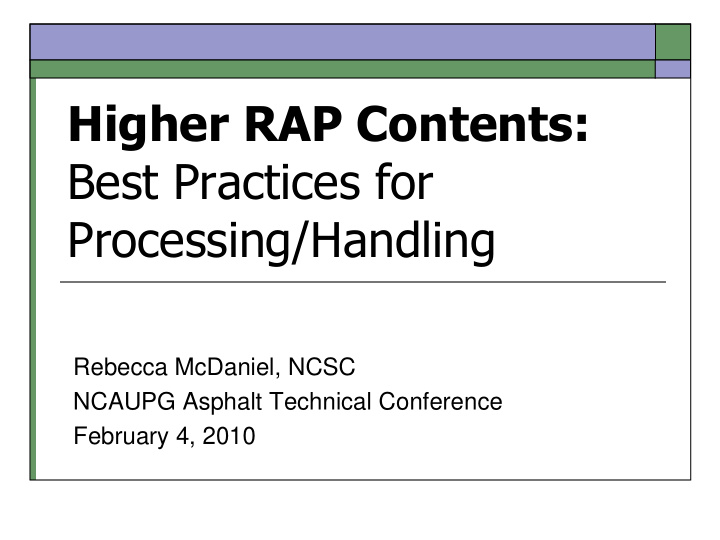



Higher RAP Contents: Best Practices for Processing/Handling Rebecca McDaniel, NCSC NCAUPG Asphalt Technical Conference February 4, 2010
Increased RAP Contents Economic and environmental pressures Interest in using more RAP in more mixes AASHTO specifications allow easy use of up to 25% RAP Can go higher with more testing Some states do not allow higher percentages or use in some types of mixes
Ongoing work NCHRP 9-46, Improved Mix Design, Evaluation and Materials Management of High RAP Content HMA (NCAT) - completion 2010 FHWA Funded, Development of High RAP Content Mix Guidelines and Informational Documents (NCAT/ NCSC/UNH) – completion 2010 FHWA HMA Recycling ETG – ongoing Other state studies ongoing All will offer more guidance.
RAP mixes can perform as well as or better than virgin mixes. So, what can you do to help ensure success?
Some Keys to Success Processing the RAP Stockpiling the RAP Control during production
Milling Removes old/distressed pavement Eliminates costly shoulder work Maintains drainage features Valuable rehab option
What to do with the RAP?
In GOK Pile After Processing
Processing RAP Mixed RAP can be variable Crushing/Screening to break up clumps Processing can improve uniformity Uniformity essential to meet specifications
Fractionating RAP Improves uniformity (remixes) Allows use of different sizes to meet mix volumetrics Allows better control of gradation (and binder content)
Fabric Contamination
Proper care yields consistent material
Stockpiling Practices Avoid segregation Avoid contamination Reduce stockpile moisture
Segregation Follow normal stockpiling techniques to minimize segregation Building Managing Pulling material
Contamination Stockpiles intermixing – spread out Putting wrong material in stockpile – label clearly “Dirty” stockpile – pave stockpile area Tracking mud into pile – install drainage to help keep area dry, mud off loader tires
Buried Stockpile Material Sinks into Ground Under Unpaved Stockpile Material Sinks into Ground Under Unpaved Stockpiles (Mineral Fines and Moisture Collect)
Reduce Stockpile Moisture Reduce fuel consumption and drying costs by keeping your materials dry Lower moisture leads to increased production capacity Lower maintenance and fuel costs for loaders Lower paving costs
Impact of Stockpile Moisture Expect to Lose 12% Production Capacity for Every Percent Stockpile Moisture Above 2% Every 2% Underestimation of Stockpile Moisture Produces 0.1% Excess Asphalt Content
How to Reduce Moisture Paved stockpile area Sloped stockpile area Cover stockpiles
Benefits of Paved Stockpile Reduced contamination Reduced moisture
Benefits of Sloped Stockpile Moisture drains to bottom of pile On slope, moisture drains away Slope grade 3 to 4 Pick off high side of pile Face slope towards sun to more drying Can reduce moisture 2% overall
Stockpile With Ideal 4 Percent Slope Moist istur ure e Drains ins to Bottom of Dry ry Mater erial ial Stock ckpile le Front side of Back side stockpile of stockpile
Covered Stockpiles Especially in high moisture areas
Mix Plant Operations
Plant Control Control plant inputs (cold feeds) Control material variability Follow-up QC/QA results Watch drum flighting – maintain protective RAP veil Avoid overheating mix Normal production care and attention
Summary of RAP Best Practices Process RAP and stockpile Fractionate RAP Avoid contamination Keep the RAP dry – paved and sloped area, covered stockpile Watch plant production
Thanks to: NAPA, AASHTO, FHWA, APAI sponsored workshop, Materials and Energy Conservation in Hot Mix Asphalt Available on NAPA website Gerry Huber And to you!
Recommend
More recommend